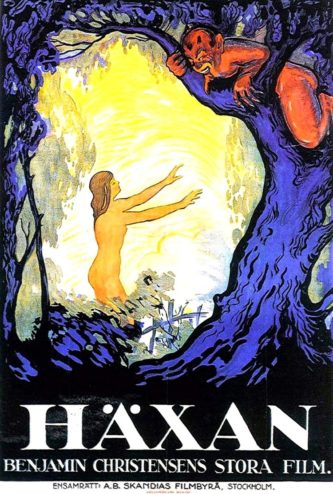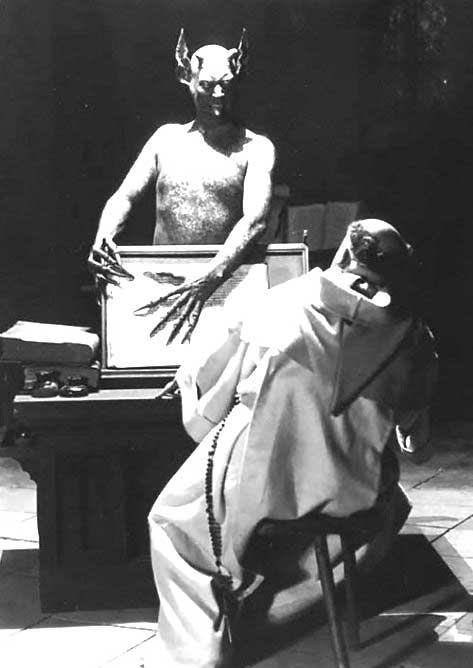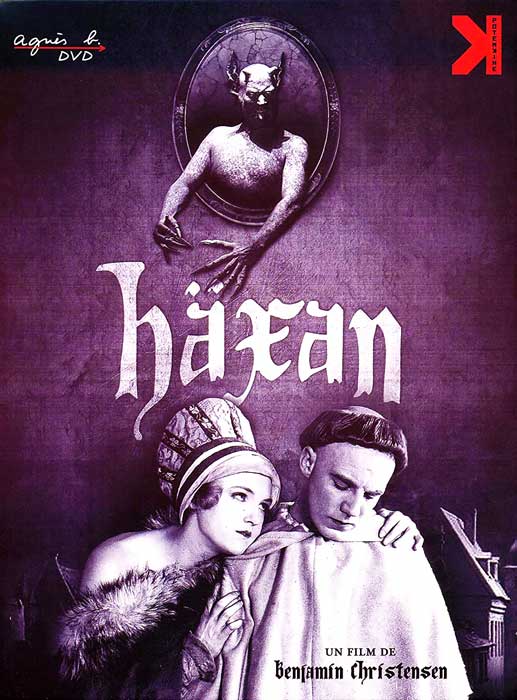 Here’s an unquestioned silent movie masterpiece, a sort-of documentary on witchcraft in the Middle Ages that was perhaps the first true cult movie. One of the weirdest and most outrageous films of all time, HAXAN remains quite relevant—and even, in its own inscrutable manner, contemporary.
Here’s an unquestioned silent movie masterpiece, a sort-of documentary on witchcraft in the Middle Ages that was perhaps the first true cult movie. One of the weirdest and most outrageous films of all time, HAXAN remains quite relevant—and even, in its own inscrutable manner, contemporary.
…one of the truly groundbreaking films of the silent era…
HAXAN (THE WITCH), which premiered in 1922, was one of the truly groundbreaking films of the silent era, and its never-before-attempted mix of documentary and staged drama remains revolutionary. Its genius creator Benjamin Christensen had started out as a singer and sometime actor, moving into directing with THE MYSTERIOUS MR. X in 1915. He helmed several more films before HAXAN, his most monumental and expensive production, with the remainder of his career devoted to more commercial fare. A sojourn in Hollywood wielded more disappointing films, with the highlight being the saucy dark comedy SEVEN FOOTPRINTS TO SATAN (1929). Christensen returned to his native Holland in the mid-1930s and lived out the remainder of his life there until his death in 1959.
HAXAN was extremely controversial in its day, inspiring withering critiques from commentators in its native Denmark (it was in fact a Swedish production, but filmed in Denmark) and banned outright in many countries. Yet the film refused to die, and was given a well-publicized re-release in 1941. Many years later, in 1968, a new version was prepared by the British exhibitor Anthony Balch, with a jazz score and droll narration by William Burroughs, entitled WITCHCRAFT THROUGH THE AGES.
HAXAN was extremely controversial in its day, inspiring withering critiques from commentators in its native Denmark … and banned outright in many countries.
 This film, as is made clear in its very first image—an intense close-up of its creator’s face—is the obsessive testament of Mr. Christensen. He shares with us many of the things he’s learned relating to the topic of superstitious persecution during the Middle Ages. First we get an illustrated lecture on the occult beliefs of ancient peoples who believed, among other things, that the sky was held up by giant metal pillars.
This film, as is made clear in its very first image—an intense close-up of its creator’s face—is the obsessive testament of Mr. Christensen. He shares with us many of the things he’s learned relating to the topic of superstitious persecution during the Middle Ages. First we get an illustrated lecture on the occult beliefs of ancient peoples who believed, among other things, that the sky was held up by giant metal pillars.
Before long we come to the first of Christensen’s dramatic vignettes, about a woman who uses witchcraft to turn a monk she fancies into a lust-crazed maniac. Another woman enchants an annoying man by making his mouth perpetually hang open.
Such women, it was widely believed, were in league with the Devil, who we see tempt an old lady with piles of gold. That same old lady is later captured by Pope-appointed witch hunters, who subject her to torture and force her to detail her dealings with Satan. We see her confessions enacted in delirious vignettes which include witches flying through the air on broomsticks, gleefully dancing on crosses and lining up to kiss the Devil’s ass.
Christensen reveals that “over 8 million” accused witches were tortured and murdered. Apparently things are better, though, in “modern” times, as it was determined that the behavioral symptoms previously thought to indicate a witch were actually those of hysteria and kleptomania.
 HAXAN has been written off by some as a lightweight wallow in dark-humored depravity, but the transcendent power of its imagery is undeniable. Benjamin Christensen’s use of single-source illumination and painterly visual compositions gives his images the feel of medieval frescos sprung to life, and the crazier scenes, such as possessed nuns running wild and witches cavorting in wild nighttime orgies, might have been plucked intact from the fevered imaginings of a Sixteenth Century witch hunter.
HAXAN has been written off by some as a lightweight wallow in dark-humored depravity, but the transcendent power of its imagery is undeniable. Benjamin Christensen’s use of single-source illumination and painterly visual compositions gives his images the feel of medieval frescos sprung to life, and the crazier scenes, such as possessed nuns running wild and witches cavorting in wild nighttime orgies, might have been plucked intact from the fevered imaginings of a Sixteenth Century witch hunter.
Just how serious Christensen’s intent was in scenes of witches lining up to kiss the Devil’s ass and turning into giant cat monsters remains a source of debate. Some of the “facts” Christensen relates, most notably the wildly disputed figure of the “8 million” murdered women, have been called into question. But the illustrated lecture segments are done with real earnestness and a great deal of voluminous research (the Criterion DVD includes a bibliography listing the many, many manuscripts Christensen consulted for the film). If this is indeed an exploitation movie than it’s certainly one of the most learned and complex potboilers of all time.
If this is indeed an exploitation movie than it’s certainly one of the most learned and complex potboilers of all time.
Ultimately it’s Christensen’s ingenious use of the silent medium that makes his film the one-of-a-kind masterwork it is. Christensen claimed in a filmed 1941 introduction to HAXAN that it could only work in a silent format (“What would the Devil say?”), and he was right. Which brings us to Christensen’s most effective innovation: his use of actual dialogue in place of the standard babbling of silent movie actors. The fact that the old woman in the film’s interrogation scene, portrayed by 78-year-old Maren Pedersen (a non-actress Christensen reportedly “discovered” on a street corner), is clearly mouthing actual words during her extended close-up makes the scene all the more effective—indeed, I’d venture to say it’s one of the most powerful close-ups in film history.
…one of the most powerful close-ups in film history.
Then there’s the modern-day conclusion, which is admittedly flawed. It attempts, in laughably histrionic fashion, to rationalize the strange and fantastic events of the rest of the film, which is a big let-down—although the final dissolve, from an institutionalized woman showering to witches being burned alive, packs quite a wallop.
See Also WITCHCRAFT THROUGH THE AGES about the making of HAXAN.
Vital Statistics
HAXAN (a.k.a. THE WITCH; WITCHCRAFT THROUGHOUT THE AGES)
Svensk Filmindustri
Director: Benjamin Christensen
Producer: Charles Magnusson
Screenplay: Benjamin Christensen
Cinematography: Johan Ankersjerne
Editing: Edla Hansen
Cast: Benjamin Christensen, Maren Pedersen, Astrid Holm, Karen Winther, Wilhelmine Henriksen, Kate Fabian, Oscar Stribolt, Clara Pontoppidan, Alice O’Fredericks, Johannes Andersen, Elith Pio, Aage Hertel, Ib Schonberg, Tora Teje, Poul Reumert, Albrecht Schmidt
